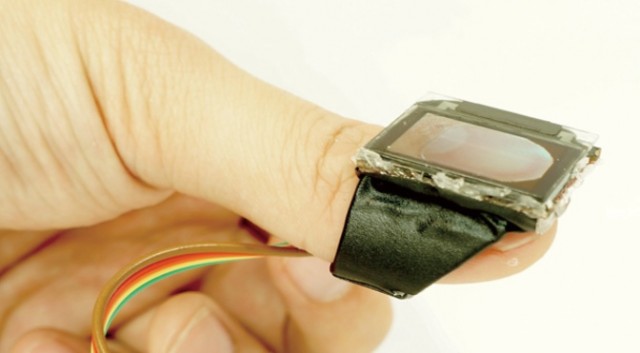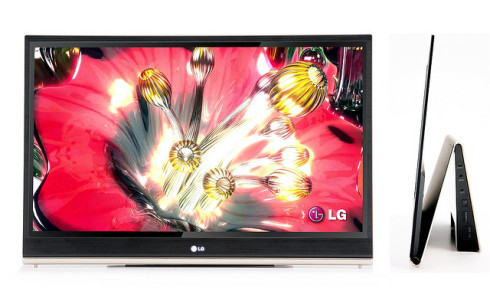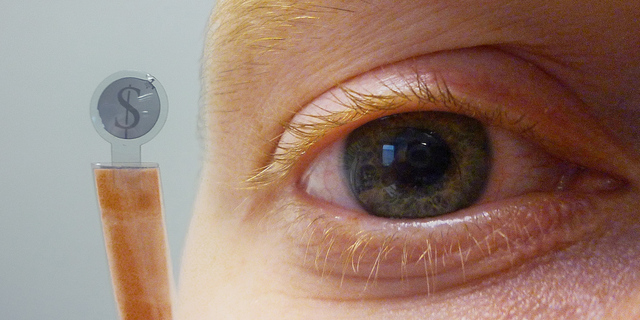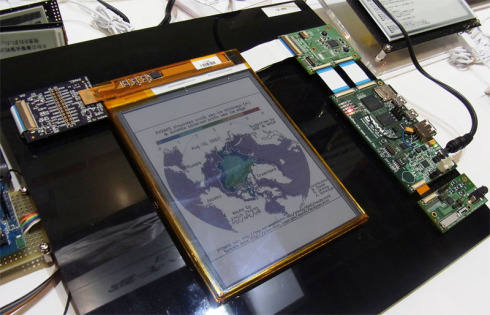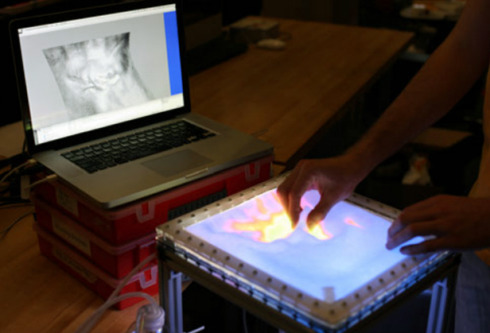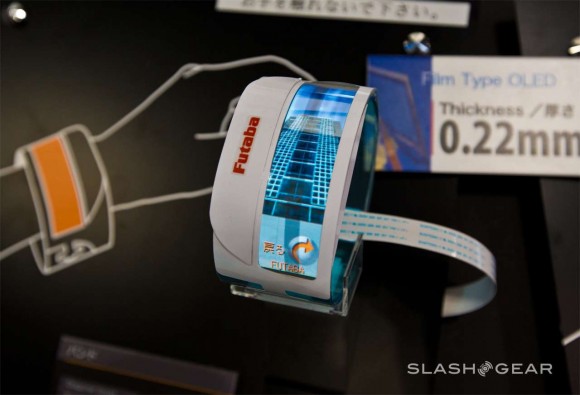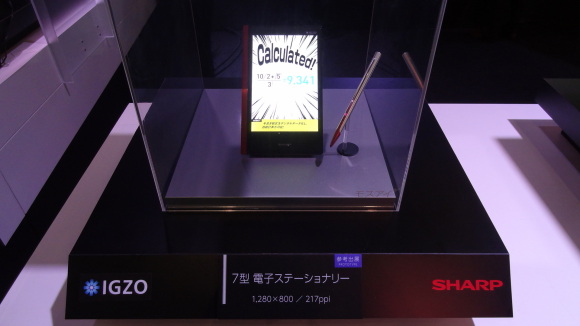
Image via Discovery News
Transparent Solar-Cell Screen Charges Phone "Startup Ubiquitous Energy, a spin off from the Massachusetts Institute of Technology, is developing a technology that makes the solar cells themselves transparent by using materials that only absorb infrared and ultraviolet light and let visible light pass through. Researchers at the University of California Los Angeles (UCLA) are taking a similar approach, while researchers at the University of Cambridge are weaving solar cells into organic light emitting diode (OLED) displays, where they can capture light leaked from the edges of the OLED elements as well as from outside the phone." via Discovery News
Society For Information Display Applauds Winners at Display Week 2013 "Display of the Year: Granted to a display with novel and outstanding features such as new physical or chemical effects, or a new addressing method. Gold Award: Sharp and Semiconductor Energy Laboratory (SEL) for Sharp's IGZO LCD (as used in the AQUOS Phone Zeta SH-02E). Silver Award: Shenzhen China Star's 110-inch 4K x 2K 3D TFT-LCD TV" via PRNewswire
Worldwide Microdisplays Market "Microdisplays are small displays that require magnifying optics to use them. These displays are made of a CMOS chip that includes a two dimensional array of transistors. In combination with the liquid crystal material, a cover glass yields a reflective LCD. Microdisplays are generally used in head mounted displays, projectors, view finders, or in other lens view display systems. Continuous and rapid development in display technology has made the way for different types of displays in the commercial market in the past few years." via SBWire
Amazon Acquires Display Maker Liquavista "Liquavista uses a technology called electrowetting to develop color displays for e-readers and portable media players. The first commercially available electrowetting display panels are expected to arrive this year, according to the Digital Reader. ...Electrowetting produces displays with advantages in a couple of key areas—viewability in various lighting conditions and low-power video playback. Amazon, a leading maker of both ereaders and tablets, may be interested in Liquavista's technology for both device categories." via PCMag
New Quantum Dots Make Colors in LCD Even Brighter "In work that appears to tip the scales further for quantum dot-enabled LCDs, researchers at the University of Illinois at Chicago (UIC) have developed a method for doping quantum dots that will give LCDs a color vibrancy not seen before. In research published in the ACS journal Nano Letters ("Cluster-Seeded Synthesis of Doped CdSe:Cu4 Quantum Dots"), the UIC team reveal a method for introducing precisely four copper ions into each and every quantum dot. This doping with copper ions opens up the potential for fine-tuning the optical properties of the quantum dots and producing extraordinarily bright colors." via IEEE Spectrum
Japan Display expands manufacturing "Japan Display President Shuichi Otsuka announced yesterday that the company is boosting capacity of high-definition LCD manufacturing at its plant in Chiba as it has set its target sales this year at 800 billion yen (7.8 billion US dollars), almost double the 450 billion yen it earned last fiscal year. “Our business is now on track,” said Otsuka, who previously was CEO at Elpida Memory Inc. “Our technology is unique, so it won’t be easy for other companies to do the same.” By competitors, Otsuka means companies like Sharp Corp. also from Japan, South Korea’s LG Electronics and Samsung Electronics Co. and Taiwan’s Innolux Corp., also big names in the display-making industry and sharing the market with Japan Display. Japan Display’s share of the global market for small- and mid-sized LCDs was 16.6 percent in 2012, Sharp Corp. held 14.8 percent, followed by LG Display Co.’s 13.5 percent and Innolux’s 10.2 percent." via Japan Daily Press
Display database for engineers Search thousands of display panels by multiple characteristics and compare results side-by-side using the display database multisearch.
Displays market loves LED lighting "In conclusion, the benefits of using LED lighting in an automotive environment has several positive implications. First, they never need to be replaced, since their solid state longetivity is in excess of 100K hours – equivalent to 11.5 service years, thereby surpassing the life of the vehicle. This allows automobile manufactures to permanently embed them into “in cabin” backlighting without requiring accessibility for replacement. Styling can also be dramatically altered as LED lighting systems do not require the depth or area as do CCFL bulbs." via Electronics Weekly
Glasses-free 3D display for theaters "It is not surprising that almost every movie is now produced in 3D. An additional incidental benefit is a reduction in illegal in-theater recording of movies. However, there are several reasons why some people are against 3D movies, in particular the discomfort of wearing special glasses. Yet, even though glasses-free 3D display technology has been commercialized for personal devices, such as the Nintendo 3DS, significant limitations must still be overcome for theater-scale projection. For glasses-free display, special optical parts must be installed in front of the screen, which interrupts original images from a projector and is incompatible with conventional theaters. ...To meet this demand, we have developed a glasses-free, front-projection 3D theater display system.2" via SPIE
Application scenarios for interactive OLED data-eyeglasses "The interdisciplinary project FAIR is funded by the Federal Ministry of Education and Research (BMBF). It is dedicated specifically to the support of physical functions by using “hand-free applications in augmented reality“ (FAIR). Within this joint-project demonstrators for innovative human-machine-interactions will be developed. A display – similar to eyeglasses – represents the visionary interface. The control and interaction with the display will be achieved via eye movements. Thus the displayed elements can be seen but provide at the same time the possibility for interaction. This enables the user to start different computer-controlled actions via eye movements. The first steps within FAIR will focus on three special application scenarios: assistance and interaction systems for persons with disabilities, innovative human-machine-interfaces in the field of entertainment as well as information- and augmented-reality-interfaces in industrial maintenance scenarios." via nanowerk
Researchers turn regular LCDs into touchscreen "Doctoral students Ke-yu Chen and Sidhant Gupta work in the Ubiquitous Computing Lab on campus. They came up with the idea for their project, uTouch, while working on a similar project called LightWave that tested how the energy given off by any electronic devices in someone’s house and even by the human body can be manipulated to control an electronic device. The energy, called electromagnetic interference (EMI), is what caused a light bulb to dim and brighten as they moved their hands closer and farther away from the bulb. “We thought that the monitor could have a similar effect,” Chen said. It did. Chen said an LCD monitor radiates EMI, also called noise, to the power line when it is turned on. The EMI increases as the human hand approaches the screen, and uTouch captures the EMI variations and uses them as signals to detect a touch gesture." via The UW Daily
Is touch really the future of the PC? "Right now the best touch pads have an accuracy of 1mm the best touch screens have an accuracy of 7mm. Right off the bat we can see that a touch screen is 7-times less accurate than a touch pad. But there is more to it. When you use a touch pad your eyes are on the object you want to manipulate on the screen while your finger is on the pad. When you use a touch screen your finger is on the screen often blocking the item you want to manipulate. Now consider that the average finger is about 10mm across. You are now blocking the area you want to work on with your finger, which is larger than the sensor in tour touch screen." via Decrypted Tech
Scientists Discovered a New Less Expensive Technique of Creating 3D Images "Scientists at University of Glasgow's School of Physics and Astronomy discovered a new less expensive technique of creating 3D images. They created a system which makes use of the detectors that have single pixel for sensing the light instead of various pixels used in imaging sensors found in digital cameras. The detectors have the capability of judging the frequencies beyond visible light, which in turn would help in various new applications for 3D imaging in geography and medicine. The scientists explained that the single pixel detectors will cost just a few pounds in comparison to present systems which amount to thousands of pounds. " via Jagran Josh
Say Goodbye to the Sharp that We Knew "If we look at the difference between consolidated LCD sales and gross LCD sales before eliminating internal transfers, we see that only 50% to 60% of sales were external transactions in 2008–2012. The portion of external sales increased in FY2013 but the LCD assets in Sakai were removed from consolidation as part of Sharp’s effort to lighten its balance sheet in September of 2012. That means sales from Sakai’s Gen-10 lines no longer contribute to operating results. The problem with that is Sharp’s own capacity becomes only 3% of the industry and that share is declining. Sharp is already smaller than China Star (CSOT) on a consolidated business basis. Thus, Sharp has few alternatives to becoming more of a merchant supplier to other brands, like Samsung." via Display Central
Do you have content to share with Display Alliance? Anyone can post press releases, white papers, commentary, videos, and more in the open section.
Europe honours LCD screen pioneer Martin Schadt "In 1970 the Swiss physicist achieved a breakthrough that would pave the way for LCD read-outs at first on calculators, watches and alarm clocks, and then flat-panel TVs, laptops and smartphones. But one year later his employer, Roche, thought the feat was a mismatch with its other pharmaceutical-focused efforts and canned the project. Thankfully, the decision proved short-lived and Dr Schadt helped the firm become a major supplier to the screen-making industry, as well as making further contributions to the technology's evolution. His admirers know him as the "father of the pixel", and this week the European Patent Office gave him its lifetime achievement award, noting that sales of devices featuring LCD panels totalled $120bn (£80bn) in 2012." via BBC News
Use of quantum dots with LCD screens in consumer devices edging closer to reality "Quantum dots are very small bits of semiconducting nano-crystals—they're useful because they can be confined in three spatial dimensions allowing for very tight control of emitted light at precise wavelengths. Shining a light through them produces exceptionally pure colors—applying trillions of them to a thin film allows for the display of color richness never before seen with LCD devices. Researchers have been raving about the benefits of the technology for several years while manufactures have been promising that devices with the technology would soon become available to consumers. It appears that such promises are finally about to come to fruition." via Phys.org
Apple going back to Samsung as LCD panel supplier "The industry believes that one of the reasons Apple has decided to come back to Samsung Display is because of its ability to get its hands on thin glass. Thin glass is a major component used in LCD displays that can be found in mobile devices—Apple uses them in its iPhones and iPads." via iDownloadBlog
Europe's largest liquid crystal display factory opened in Ventspils, Latvia "In its new plant in Ventspils Ltd. "EUROLCDS” will produce different types of passive liquid crystal display technology based products. The goal of the company is the global market (Europe and the USA), but primarily the European cluster of LCD products. Liquid crystal display materials will be supplied mainly from China and Japan. One of the largest business segments of the factory will be production of glass that automatically darkens when exposed to bright light for welding masks. Road signs and information display products that use EASL Polydisplay technology will also be produced. At present, the company employs 20 employees, but with the business growing, the number of employees is expected to increase up to 50; in the future there might be 50 more employees employed in distribution and administrative proceedings." via Ventspils.lv
Transparent graphene-based display could enable contact lens computers "The researchers were able to build miniature inorganic LEDs by connecting the graphene sheets together with silver nanowires into a hybrid structure. The flexible silver nanowires enabled the hybrid strucuture to maintain its high conductivity even when bent. The most important factor for using the hybrid graphene in a contact lens-based computer is its high transparency. Other transparent materials like indium tine oxide (ITO) become much less conductive when bent. When the hybrid LEDs were embedded into a regular soft contact and tested in a rabbit no ill effects were observed." via ExtremeTech
Government aid helped make Sharp's IGZO crystals a reality "To develop IGZO, Hosono received research funding from the Japan Science and Technology Agency (JST), an independent administrative agency affiliated with the science ministry. The agency provided 1.8 billion yen ($18 million) of funding for a five-year period beginning in 1999. Of that, around 100 million yen was used for basic research on IGZO. IGZO is dozens of times more conductive than silicon. It can make smaller TFTs and give high-definition quality to liquid crystals." via The Asahi Shimbun
The Future of 3D TV and Why ESPN Dropped Its Pioneering 3D Channel ""3D does cause people to switch off in its present form,” admitted Andy Quested, BBC’s head of 3D and HD. “About 20 percent of people find sports matches in 3D simply too long. Twenty-five percent of people are apathetic toward 3D viewing no matter the content. Another 10 percent can’t see 3D because of visual impairments, but arguably up to half the audience for 3D content is put off by having to wear glasses." Dolby is among the stakeholders arguing that glasses simply won’t work in the home." via The Hollywood Reporter
Are you an engineer or have display expertise? Email jason@displayalliance.com to be featured in the interviews section.
Innolux sales drop after ceasing touch display operations "In a statement issued on Friday, Innolux reported consolidated sales of NT$37.47 billion (US$1.25 billion) last month, down 8.4 percent from a month earlier and also down 5.2 percent from a year earlier.
At an investor conference on May 9, Innolux said the termination of its touch display enhancement technology operations would cut its sales by about NT$5 billion during April and last month, but its gross margin would improve accordingly." via Taipei Times
Hon Hai Annoints Display Research Center In Japan "Hon Hai Precision Industry announced that it has established a research and development center in Japan to focus on display screens and touch panels. As a part of its diversification strategy, Hon Hai is reportedly expanding its businesses outside the OEM sector. The company has continued to invest in the display screen sector; in 2012, Hon Hai acquired a 38% stake in Sharp's Sakai TV panel factory." via China Tech News
New tactile display sends information through skin instead of eyes "Your sense of touch could be the next frontier in relaying valuable contextual information if new research currently being conducted at MIT proves successful. Researchers believe it may be possible to design wearable arrays of GPS-enabled vibration motors that provide simple navigational cues or detailed data through a kind of tactile Morse code. This could lead to non-visual haptic display technology — why not check your email without even opening your eyes?" via ExtremeTech
New Technology Creates Unbreakable Smartphone Display "The plastic substrate created by Professor Yoon and his research team have greatly enhanced needed properties of heat resistance, transparency, flexibility, inner chemical capability, and tensile strength. Although the material retains flexibility as a native advantage of plastic film, its tensile strength is three times greater than that of normal glass, which is a degree similar to tempered glass. In addition, Professor Yoon’s substrate is as colorless and transparent as glass and resists heat up to 450℃, while its thermal expansivity is only 10% to 20% of existing plastics." via PCB 007
How supersensitive screens get touch-y "Have you seen a diagram of a mobile phone display? It's a lot more than the cover glass you're worried about shattering when you drop your phone. There are layers that stack up to form the whole package, from the coated cover glass on top through filters, substrate glass, and screen material, like the LCD or OLED sheaves that actually turn pixels on and off to create the picture you see on the screen." via CNET
A Pleasure To Touch: Advanced Human Machine Interface Touchscreens For Vending "Engineers need to consider three key factors when looking to embed touch control into vending machines. 1. The specified touchscreen solution must be durable, as these pieces of equipment are designed for 24/7 public use. Furthermore, some venders may be deployed in a variety of environments, including outdoors, where they will be subjected to wind, moisture and extreme temperatures. As the machines may be located in lightly supervised areas, the chosen touchscreen should be resistant to deliberate harm from vandalism, in addition to accidental scratches from users' watches and jewelry." via Vending Times
Wearable Computing Pioneer Says Google Glass Offers “Killer Existence” " [Another] thing is that we’re going to see these interfaces that augment the user’s eyes, ears, and mind in such a way that it actually helps with their daily life instead of distracts them. Suppose you’re playing a video game or watching TV. Having something that actually shows you the TV guide or a second screen while you’re doing other things is really powerful." via MIT Technology Review
Developing 3D gesture-based car dashboards "One common aspect of the systems now emerging is that the touch screen head unit represents the nexus of an ever-growing diversity of input signals such as television and DVD, live video and graphics from advanced driver assistance systems, status information from various vehicle sensors, Bluetooth communications, GPS and mapping, and Internet content such as traffic updates, news feeds and social media notifications. User interface design is critical if drivers are to gain the maximum benefit from interacting with the system without suffering distractions or information overload. Considerations for designers extend beyond the layout and menu structure to encompass multiple ways of interacting with the system; touch, gesture and voice control will all be necessary, in addition to control using buttons on the console and steering wheel." via ElectronicsWeekly
What did you think about today's news? Leave a comment here and share your thoughts.

 Display Alliance
Display Alliance

